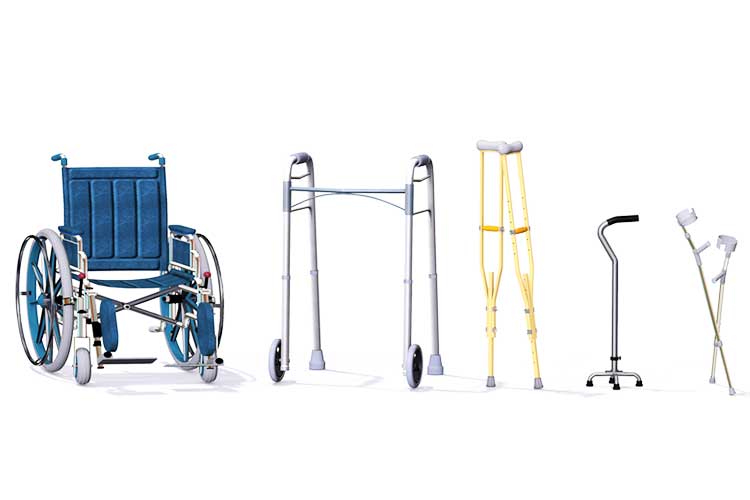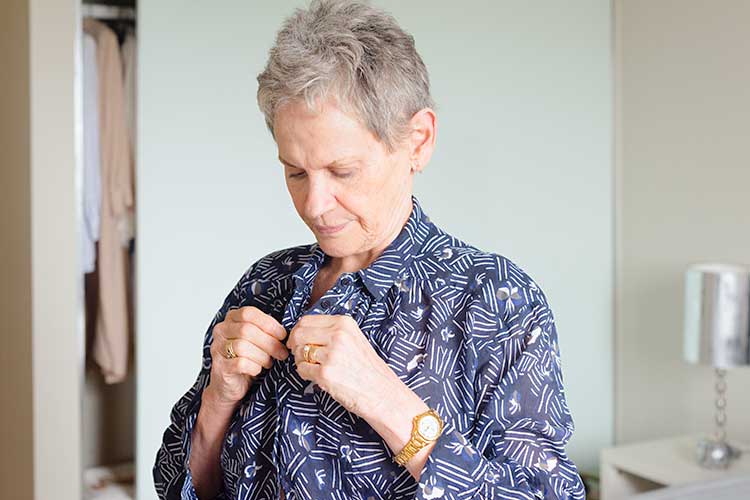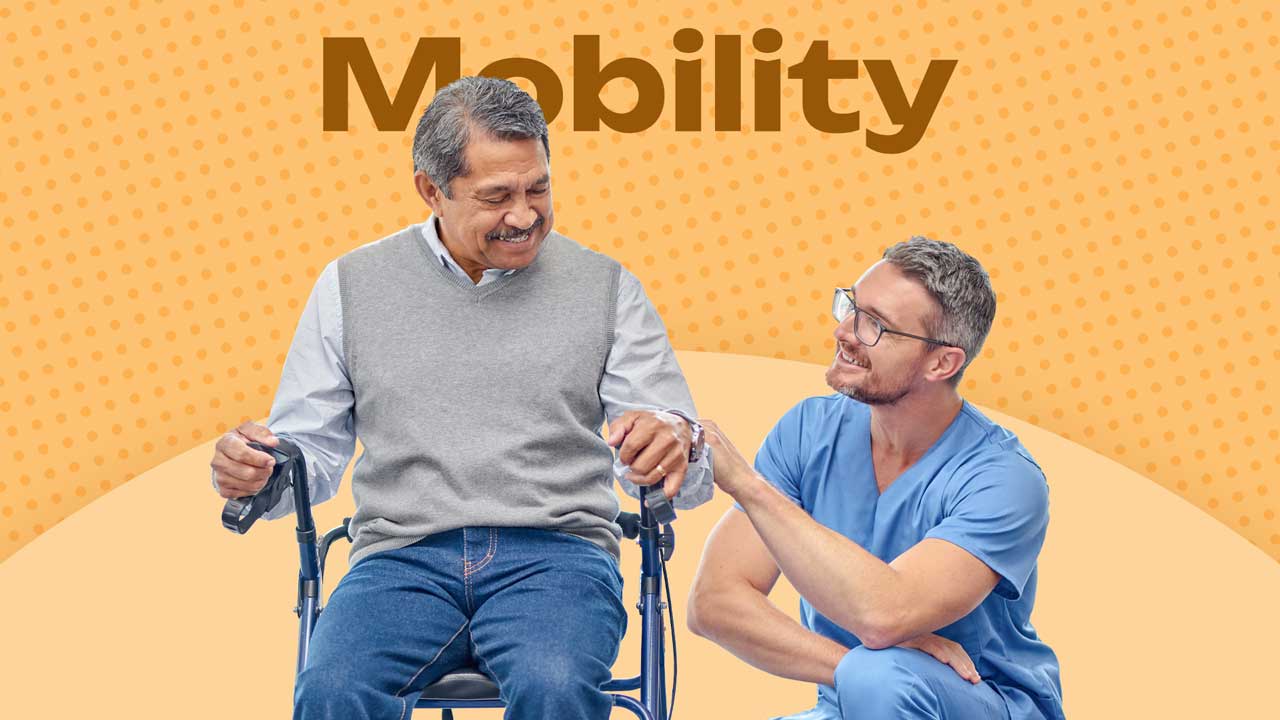There are many considerations to keep in mind when caring for a client who lives with impaired or limited mobility.
Why is Mobility Important?
Mobility is closely tied to our sense of independence, but also our social connectedness, activity, and security (Health.vic 2015a). A person's wellbeing can be considerably compromised by a mobility restriction.
Mobility impairment can range from limitations of stamina to total paralysis (Illinois University Library 2023).
Often, a lack of functional mobility can contribute to health issues such as falls, incontinence, and malnutrition (Health.vic 2015a).

The Effects of Facilitating Mobility and Self-Care
By encouraging and helping a client to achieve or regain mobility, the risk of the following decreases:
- Depression
- Delirium
- Malnutrition
- Falls and fall-related injuries
- Loss of confidence due to fear of falling
(Health.vic 2015a)
The Effects of Long-Term Bed Rest Due to Mobility Restriction
In a situation in which drastically reduced mobility results in bed rest, there is a heightened risk of additional health complications:
Cardiovascular
- Postural hypotension
- Reduced aerobic capacity.
Respiratory
- Reduction in arterial oxygen level
- Increased potential for atelectasis.
Musculoskeletal
- Reduced muscle mass
- Reduced muscle strength
- Muscle shortening
- Joint contractures
- Reduced bone density
- Increased risk of falls/injury
- Pain.
Gastrointestinal
- Constipation
- Malnutrition.
Genitourinary
- Continence issues.
Skin
- Breakdown in skin integrity.
Psychological
- Confusion
- Social isolation
- Depression.
(Health.vic 2015a)
Mobility Limitations in the Home
A client living with reduced mobility may find it difficult to carry out simple tasks and participate in activities without assistance.
It is important to ensure their home environment allows them to live as independently as they would like to.
The following are recommended as basic aids to assist a client to live independently at home:
- Cleaning and laundry aids
- Kitchen and laundry fixtures
- Can and jar openers
- Preparing and cooking utensils
- Customised scissors
- Handrails
- Shower rails
- Ramps
- Easy-use taps
- Trays and over-bed tables
- Reaching and turning aids
- Walking and standing aids
- Dressing and grooming aids
- Remote control devices
- Sitting and sleeping support
- Slip-resistant mats and grip aids
- Scooters and wheelchairs
- Intercoms and emergency call systems.
(Better Health Channel 2015)
What is ‘Functional Mobility’?
Functional mobility is the capacity to move from one position to another, enabling participation in everyday life.
Functional mobility includes:
- Bed mobility
- Transfers
- Walking
- Wheelchair mobility
- Accessing toilets
- Getting in and out of a car
- Driving and taking public transport
(Health.vic 2015b)
Mobility restrictions and the use of gait aids can significantly impact a person’s ability to access their home and local area. This can cause difficulty maintaining and initiating social connections within their community (Health.vic 2015c).
Mobility Aids

Read: Understanding Mobility Aids
Mobility aids are pieces of equipment that facilitate movement for people who would otherwise be unable or limited in their attempt to move, or participate in or carry out a task. Mobility aids include:
- Wheelchairs
- Walking frames
- Ramps
- Shower chairs
- Splints
- Braces
- Home oxygen services
(Better Health Channel 2023)
Tips for Looking After a Client with a Mobility Impairment
There are small changes that can be made to help a client living with a mobility restriction to move around. These include:
- Ensuring you know the client’s capacity (i.e. whether they can get out of bed on their own, how far they are able to walk, whether they need assistance).
- Always ensuring mobility aids are correctly adjusted to suit the client.
- Ensuring any tripping hazards such as furniture, mats and power cords are cleared from walkways. There should be enough unobstructed space for the client to move around safely, including when they are using a mobility aid.
- Ensuring the client’s bed is a suitable height
- Looking out for wet or uneven flooring
- Regularly checking mobility aids for damage (protruding or missing screws, split or loose hand grips, worn rubber tips etc.)
- Ensuring the client’s footwear is well-fitting, flat and non-slip.
(CEC 2017; Independent Living Centre 2019; Health.vic 2015c; Gramenz & Dymock 2023)
Exercise
Exercise programs may include strength, balance, functional retraining, and aerobic exercises (Health.vic 2015c).
The exercise undertaken by people with mobility limitations does not need to be strenuous. Exercise can even be performed through incidental activity - physical activity that occurs as part of a daily routine. Examples include:
- Getting out of bed
- Walking to the toilet
- Getting dressed
- Eating meals outside of bed
- Showering and grooming
(Health.vic 2015c)
As well as facilitating exercise, incidental activity is also beneficial in encouraging self-care (Health.vic 2015c).
These activities can be performed with supervision or assistance if required (Health.vic 2015c).

Falls Prevention
From 2021 to 2022 alone, over 233,000 people were admitted to the hospital after a fall (AIHW 2023).
It is important to note that most falls requiring hospitalisation occur in the home (AIHW 2023).
Despite this, falls are often preventable (Better Health Channel 2022).
Read: Minimising Falls Risk in the Home
Conclusion
A mobility impairment has the potential to severely impact an individual's wellbeing, causing isolation, fear of falling, increased bed rest, and dependency on others for simple tasks. Limited mobility can be navigated through accessible home environments, support, and exercise programs.
Test Your Knowledge
Question 1 of 3
Which one of the following is less likely as a result of encouraging and helping a client to achieve or regain mobility?
Topics
References
- Australian Institute of Health and Welfare 2023, Injury in Australia: Falls, Australian Government, viewed 19 July 2024, https://www.aihw.gov.au/reports/injury/falls
- Better Health Channel 2023, Aids and Equipment at Home, Victoria State Government, viewed 19 July 2024, https://www.betterhealth.vic.gov.au/health/servicesandsupport/aids-and-equipment-at-home
- Better Health Channel 2015, Disability and Aged Care, Victoria State Government, viewed 19 July 2024, https://www.betterhealth.vic.gov.au/health/servicesandsupport/disability-and-aged-care
- Better Health Channel 2022, Preventing Falls at Home, Victoria State Government, viewed 19 July 2024, https://www.betterhealth.vic.gov.au/health/healthyliving/falls-prevention-at-home
- Clinical Excellence Commission 2017, Pointers for Safe Mobilisation - Give it a Go!, New South Wales Government, viewed 19 July 2024, http://cec.health.nsw.gov.au/__data/assets/pdf_file/0009/399690/Pointers-For-Safe-Mobilisation-Give-It-A-Go!.pdf
- Gramenz, J & Dymock, J 2023, How to Prevent Falls in Aged Care (& At Home), St Vicent’s Care, viewed 19 July 2024, https://www.svcs.org.au/residential-aged-care/information/how-to-prevent-falls
- Health.vic 2015c, Maintaining and Improving Mobility and Self-care, Victoria State Government, viewed 19 July 2024, https://www2.health.vic.gov.au/hospitals-and-health-services/patient-care/older-people/falls-mobility/mobility/mobility-improving
- Health.vic 2015a, Mobility and Self-Care Support Independence, Victoria State Government, viewed 19 July 2024, https://www2.health.vic.gov.au/hospitals-and-health-services/patient-care/older-people/falls-mobility/mobility/mobility-independence
- Health.vic 2015b, Understanding How Patients Move, Victoria State Government, viewed 19 July 2024, https://www2.health.vic.gov.au/hospitals-and-health-services/patient-care/older-people/falls-mobility/mobility/mobility-understanding
- Illinois University Library 2023, What is a Physical/Mobility Disability?, University of Illinois, viewed 19 July 2024, https://guides.library.illinois.edu/physicalmobilityimpairments
- Independent Living Centre 2019, Walking Aids: Using and Measuring, Government of South Australia, viewed 19 July 2024, https://www.scribd.com/document/508946000/walking-aids-using-and-measuring
 New
New 
